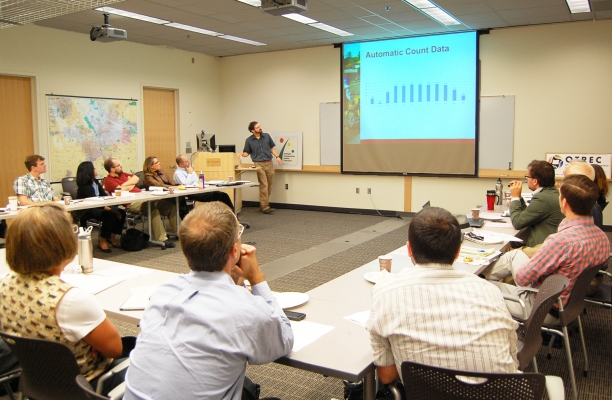Conference aims to make sure cyclists, pedestrians count

In transportation funding decisions, you don’t count until you’re counted. That fact can lead to cyclists and pedestrians, often overlooked in traffic counts, getting less than their share of transportation money. OTREC hosted a conference Sept. 15 to address that problem.
“Without the data, you have an incomplete picture of how the (transportation) system is being used,” said OTREC researcher Chris Monsere, the conference organizer. “And it’s easier to make the case for resources if you know how the system is being used.”
The conference, called the “Bike and Pedestrian Program Information Exchange & Technology Transfer Summit Meeting,” brought together officials from local and state transportation agencies and consultants to share features of the best counting programs and technology. The forum helped bridge a gap between people who count motor vehicles and those who count bicycle and pedestrian traffic.
“We wanted to raise a little awareness of both sides of the equation,” Monsere said. “There are things both can learn from the other.” <All presentations available for download at the end of this article>
Nonmotorized counting programs often get large numbers of motivated people involved quickly and have a strong network for distributing results of counts. Motorized counts tend to be more systematic and uniform.
The motorized traffic counts have a jump on their non-motorized counterparts, Monsere said. That’s largely a result of longstanding Federal Highway Administration expectations that states count motor vehicle traffic. Agencies that count nonmotorized traffic generally do so because they want to, not because they’re required to.
Liz Stolz, traffic analysis unit manager with the Colorado Department of Transportation, wanted better nonmotorized traffic data for the department’s planning, operations, construction and maintenance efforts. Her drive led to her getting a Federal Highway Administration grant to facilitate and participate in the Portland counting conference along with Betsy Jacobsen of Colorado DOT and Bill Hass of FHWA Colorado. The conference let Stolz learn from local experts and share her own experiences.
Having hard data to verify how much people use bicycle and pedestrian facilities has already made a difference in Colorado, Stolz said. In the past, the department didn’t plow one trail in winter, for example. “The maintenance folks didn’t think it was used in winter and so they don’t need to plow it,” she said. “We proved, by having a counter out there, that if you plow it, they will come.
“Now we have a contractor plow it,” Stolz said. “It made a huge difference from an operations standpoint.”
On a stretch of highway near Boulder, counts revealed that bicycles were nearly 10 percent as numerous as motor vehicles. Knowing that figure could lead to a new, divided trail alongside that highway.
Often, when state transportation officials decide to count nonmotorized traffic, the question is where to find that traffic. That’s where the existing, localized networks of volunteer counters can come in, Monsere said. “Part of the strategy is where to count,” he said. “With that network, somebody has already thought of that.”
Trails often get dismissed as purely recreation facilities, Monsere said, although many also serve as transportation routes. A presentation by Matt Berkow of Alta Planning and Design showed that bicycle traffic on trails mirrors the rush hour commute patterns of motor vehicle traffic. “If you put up the graphs and covered the title, you’d just say ‘That’s a commuting pattern,’” Monsere said.
With different agencies doing counts different ways, that can lead to problems sharing results and to duplicated efforts. A city, county and state, for example, may all count traffic in the same area without coordinating their efforts. Stolz shared at the conference how her department is working to eliminate duplication by coordinating counting activities.
Other presentations focused on why counting is necessary, how different agencies structure their counting programs and how to make the best use of count data. The conference finished with an overview of the latest counting technology and challenges associated with each mode. Tube counters, for example, can not capture foot traffic; other sensors could mistake a group of bicycles for a single vehicle.
Once officials agree that nonmotorized counts need to be done, however, the challenges aren’t that great, Monsere said. The tools to analyze data and distribute results already exist.
“It’s not much more effort to process nonmotorized counts,” he said. “The infrastructure’s all set up.”
Presentations from the conference are available here:
· National Perspectives: The TRB Joint Subcommittee of Highway Traffic Monitoring: Liz Stolz, Colorado DOT
· National Bicycle and Pedestrian Documentation Project: Matt Berkow, Alta Planning
· Collection and Use of Bicycle Count Data in Portland, Oregon: Roger Geller, Portland Bureau of Transportation
· Colorado’s Travel Monitoring Program: Liz Stolz, Colorado DOT
· Washington State Bicycle and Pedestrian Documentation Project: Ian Macek, Washington State DOT
· Metro’s Trail Counting Program: Robert Spurlock, Metro
· Proposal for a Regional Bike Counting Strategy: John Mermin, Metro
· Usage Projection Methodologies for Communities, Facilities and Corridors: Mia Birk, Alta Planning
· Using Data From Automatic Cycle Traffic Counters: Best Practices from Vancouver, Montreal and Ottawa: Jean-Francois Rheault, Ecocounter
